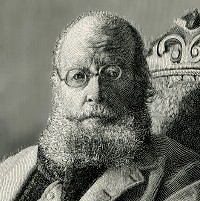Edward Lear – angielski poeta i rysownik, autor limeryków.
Pochodził z wielodzietnej rodziny , wychowała go najstarsza siostra, Anna. Sam nigdy rodziny nie założył, podejrzewany był zresztą o tendencje homoseksualne. Nie miał formalnego wykształcenia, ale wcześnie zaczął rysować i z rysunku utrzymywał się od piętnastego roku życia. Mimo słabego zdrowia był twórcą niezmiernie płodnym – pozostawił obszerne zbiory rysunków, ilustracji i obrazów olejnych, ponadto pisał wiersze i wspomnienia z licznych podróży, prowadził szeroką korespondencję, a nawet komponował. Wiele dzieł zostało wydanych pośmiertnie.
Miał talent do pozyskiwania przyjaciół, m.in. Alfreda Tennysona i Edwarda Stanleya, hrabiego Derby, który zlecił mu wykonanie rysunków ze swego zwierzyńca; przez pewien czas uczył także rysunku królową Wiktorię. Dzięki m.in. poparciu kolejnych hrabiów Derby uzyskał zamówienia, które pozwoliły mu na podróże po całej Europie, a także do krajów Lewantu, Indii i Cejlonu. Znaczną część życia spędził na południu Europy, w Grecji i we Włoszech. Przez 17 lat jego wiernym towarzyszem podróży był kot Foss.
Aczkolwiek był wybitnym rysownikiem i ilustratorem ery wiktoriańskiej, do historii przeszedł jako twórca poezji nonsensownej, w szczególności limeryków, który to gatunek rozpropagował . Spośród jego ponad 20 książek, najbardziej znaną jest A Book of Nonsense, zbiór 112 limeryków z własnymi ilustracjami.
W uznaniu osiągnięć Leara jako ilustratora książek o ptakach, jego nazwisko nosi ara błękitna .
Wikipedia
✵
12. Maj 1812 – 29. Styczeń 1888
